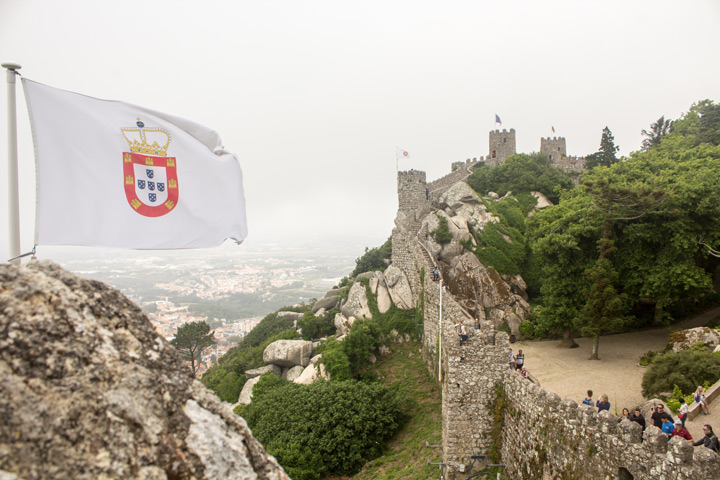Chris & Allyson vs. Europe (2017)
Portugal Day Three: Sintra. National Palace. Palacio da Pena. Castle of the Moors. Praia da Adraga.
Portugal isn't a large country. If you have a car, you can start at the northern border and finish your day on a Mediterranean beach with no problems. So when it's time to leave Lisbon, you have to ask: Why not get a car? They drive on the right. The signs are in Portuguese, but if you have satellite navigation and 10th-grade Spanish abilities, you should be able to get by. And who doesn't want the unbelievably authentic experience of tooling around a European nation in a fuel-efficient hatchback?
When planning our trip, we decided that a rental car was the way to go. This was despite my mixed overseas driving record. In my 20s, I crashed into a van in Ireland while pulling out of a driveway. But in my 30s, I successfully navigated downtown Sydney in rush hour without so much as a scratch. Under the assumption that I am getting better with age, we reserved a car at a Hertz just a few blocks from our hotel.
And that led to a mini-adventure. Between our hotel and the Hertz was the biggest traffic circle in Lisbon. After observing it for a few days, I wasn't thrilled about pulling out of the Hertz in an unfamiliar car, then driving immediately into the hellmouth in order to pick up Allyson. I'm in my 40s now, and I know there is noble dignity in admitting that you're a pussy about certain things. Allyson supportively agreed that it was OK to be a pussy, so we opted to check out of the hotel and carry our luggage to the Hertz. This was a great plan in theory. In practice, it involved me wearing two shoulder bags and pulling two wheeled suitcases up a very steep hill during rush hour. I was sweating out of every pore within two minutes. You'd like to think that cathedrals and castles are the memorable part of your vacation. In fact, three decades on, you will mostly think about the time you smelled terrible in a Hertz at 8:15 a.m.
But my labor was richly rewarded! Allow me to explain: In Portugal, most people drive manual-transmission cars. Automatic cars are in short supply and must be reserved well in advance. I absolutely needed one, so I reserved an affordable automatic-transmission economy car months ahead of time. From what I can tell, inventory management at rental car companies is an art, and not a science. I'd wager a large amount that Hertz had no automatic economy cars in the garage.
So they graciously gave us a "free upgrade!" A very nice American lady and her smelly pack mule husband soon found themselves settling into a beautiful, brand new BMW Gran Coupe. It was a generous move on the part of Hertz, and my gratitude is only slightly diminished by the likelihood that it was the only automatic car they had available that day. Our chariot for the rest of the week was very comfortable and very modern. And though we didn't appreciate it at the start, it was very large. When the ancient Romans built Europe's street grid, they clearly had fuel-efficient hatchbacks in mind. They are absolutely the best cars for navigating centuries-old alleyways. But more on that later! The important thing here is that Chris and Allyson pulled out of the Hertz, turned left on a main artery and were on their way to experiencing the glories of Portugal.
The first glory was nearby. If you drive west from Lisbon, before long you encounter the Sintra Mountains, a tiny humpback range that sits between the Atlantic Ocean and the greater metropolitan area. As weather systems blow in from the ocean, they hit the mountains and stack up. The mountains are almost always cooler than Lisbon; and depending on the day, they can be foggier and way more romantic than Lisbon. The Portuguese royals took note, and they built some kick-ass summer homes on the eastern side of the mountains.
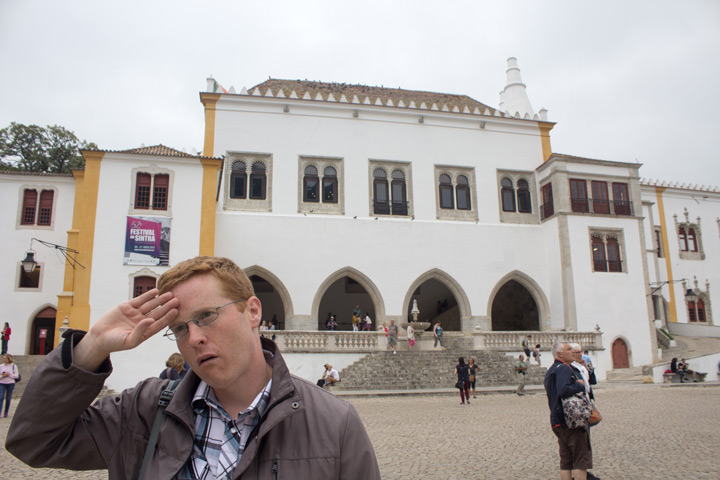
Relieved to reach the National Palace in Sintra after a parking nightmare.

Look up, dummy. Inside the Sala dos Brasoes in the National Palace.

Rolling up on the mist-shrouded Palacio da Pena.
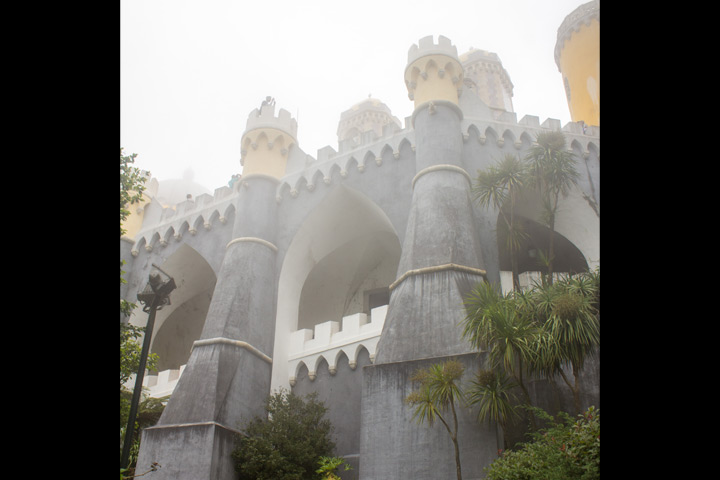
Walt Disney eat your heart out. The pastel exterior of the Palacio da Pena.

Fine dining in the Manueline style. Private quarters in the Palacio da Pena.

A view from the ramparts. Mostly a view of mist, but still pretty cool.
For all these reasons, the town of Sintra is one of the most picturesque spots in Western Europe. It has stunning mountain scenery, quasi-Medieval charm, and two awesomely gaudy palaces. The good lord invented day trips for places like Sintra.
However, the good lord did not provide adequate parking infrastructure for people trying to visit Sintra. We rolled up on the traffic jam on the outskirts of downtown at around 10:20. We slowly circled for 40 minutes, while our sat nav (in the voice of a smarmy British lady) told us to go "half left" or "half right" at every other intersection. I very nearly had a psychotic break, because I don't handle it well when my itineraries start to fall apart. But the heavens took mercy upon us. They showed us the way to a hidden parking lot, at the bottom of a hill. It was actually a parking lot I had found online months before; my mistake was ignoring the written directions and trusting the sat nav to find a parking space.There was an old guy mysteriously walking around the lot and casing the cars, and usually that means he'll key something if you don't give him money. But we didn't have time to navigate Portugal's gray market economy. We had palaces to tour.
First up was the National Palace. It started out a thousand years ago as a Moorish palace, smack in the middle of town. It was repurposed into a good Christian palace after the Reconquista, and it soon became a favorite "getaway" residence for the Catholic kings. They steadily expanded it until about the mid-16th century, when it achieved the form it more or less has today.
That form is dominated by two huge, white, conical towers. They match nothing in the surrounding town, jutting out like dunce caps or Klan hoods for giants. They are mysterious and intriguing. And it was a little bit of a letdown to learn that they are ... chimneys. Palaces host a lot of parties, and parties require big kitchens. The kitchens of the National Palace are topped with these enormous chimneys. If you need to keep the smoke out of your nice palace, it's a very grand way to do it.
There's plenty to like in the palace, because it's extremely palace-y. There are many rooms, with extravagant decorations. The Portuguese seemed to put extra attention into the ceilings and walls: lots of surfaces are covered with azulejo tiles, and the architects vaulted and paneled everything they could think of. (One ridiculous room, the Sala dos Brasoes, has a domed ceiling decorated with coats of arms for 72 noble families.) There are some nice courtyards and passages with that old Moorish flair -- geometric patterns everywhere. And the building is surrounded by some pleasant little gardens. Between the fancy wood floors, the elaborate tile walls, the ornate furniture and the brightly colored fabrics, you did NOT want to be a cleaning person for the Portuguese court.
As obscenely grand palaces go, it might be a little generic. There wasn't a wonderful story attached to the building, aside from centuries of use by the extremely wealthy. I couldn't tell you which Portuguese king liked it best, or whether that king had a terrible dark secret, like a mistress with a tail. We liked it, but we weren't blown away.
So it was on to the next palace! The National Palace is the heart of the town of Sintra. All the other cool stuff to see in the region is at the top of the mountain. We were NOT going to move the car, so instead we hired a "tuk tuk." They are, essentially, golf carts on steroids. The drivers keep looping between the town and the top of the mountain. Their entire business model relies on the fundamental laziness of tourists. In other words, it's a great business model. We had a nice chat with our driver, who liked being in Sintra, but preferred to spend his personal vacation surfing. (Portugal has some of the best surfing in the world, but the public relations office for the Portuguese Surfing Alliance is getting its ass kicked by Hawaii.) We had a nice talk about the weather, as we drove up the mountain and INTO the weather.
When we visited Alaska the year before, we noticed that promotional photos of Denali always showed blue skies. During tourist season, that awesome mountain is visible on average two or three days out of each month, and the weather patterns caused by the mountain lead to a lot of rain and overcast days. You can still have a great time (which we did), but you have to know what you're buying.
Sintra might be the Denali of Portugal. The vacation and promotional photos you'll find online have blue skies and green hillsides. That's about a 50 / 50 proposition. You can be bummed by the high odds of rain, or you can lean into it. For example, the woman who rented us BMW said it "adds to the romance." This particular Friday, Sintra was pretty damn romantic. The tops of the mountains were periodically disappearing behind clouds. Our tuk tuk took us up a winding road, through a forest and into those clouds. With romance all around us (and on us, whenever it started spritzing) we were deposited at the main entrance of the Palace da Pena.
The Palace da Pena is my kind of palace: Insane. It dates only to the mid-1800s, and it serves no function other than the personal amusement of royalty. It's a fairy tale castle, designed only to look good and impress people. It succeeds.
The guy behind it was an interesting dude. Ferdinand II was the "King consort" of Portugal, which meant his wife was the true ruler. He enjoyed all the perks of royalty, without having to deal with the pressure of being a vessel for God's will. Ferdinand was not, however, "idle rich." It would be better to call him an autodidact. He was an accomplished painter, a student of architecture, an amateur oceanographer ... This palace is what happens when you have hobbies, free time, and unlimited funding.
The building itself is constructed on the ruins of a monastery that was done in by the great earthquake. It incorporates the old cloister (we saw a LOT of cloisters this vacation), but it goes way beyond. There are towers, battlements, grand arches, courtyards, luxurious reception halls, luxurious private dining rooms, luxurious private chapels, Manueline vaulted ceilings, and gargoyles. By design, it incorporates the famous Portuguese tiles, Moorish decorative flourishes and good-old-fashioned German Romantic design. The palace is situated at the high point of a botanical park -- to get there, we walked half a mile uphill through some very spooky, misty forests. And the exterior of the building is plastered with day-glo colors. The mist made the colors and the views a little less impressive during our visit, but oh, the romance!
We paid for an audio guide, which was absolutely the right choice -- because of the huge crowds, the first half of the tour was "cattle chute" style, with everyone plodding through each room in a slow-moving line. We got to enjoy the bizarre story of Ferdinand II during our plodding. His wife, Maria II, died in 1853 from complications during the birth of their ELEVENTH child. (The complication was probably that her uterus was too tired to go on.) The throne went to his son, and Ferdinand later married an opera singer. He used the palace as his primary shackin' up location until his death. The opera singer was allowed to stay there, but she eventually sold it back to the country. After Portugal got rid of its kings, they turned the campus into the park we all now enjoy.
The world is probably now at the point where we won't see this level of Romanticism anymore. You can't build a palace for the sake of building a palace; people would destroy you on social media. Governments can't get away with this kind of flagrant waste. When you see something like the Palace da Pena, you're seeing something that won't happen again, and that makes it at least a little more special. Even with the clouds, this was better than the National Palace, and we reached that consensus while chowing on a pretty nice lunch in the Palace café.
But there was still more to see! It was literally all downhill from there. The mist wasn't misting too hard, so we set off down the mountain road to see the Castle of the Moors.

We want Moor! Sintra's stunning Castle of the Moors.

Good luck charging uphill to capture this thing. Castle of the Moors.

Looking down the mountain from the Moorish castle. That's the National Palace below.
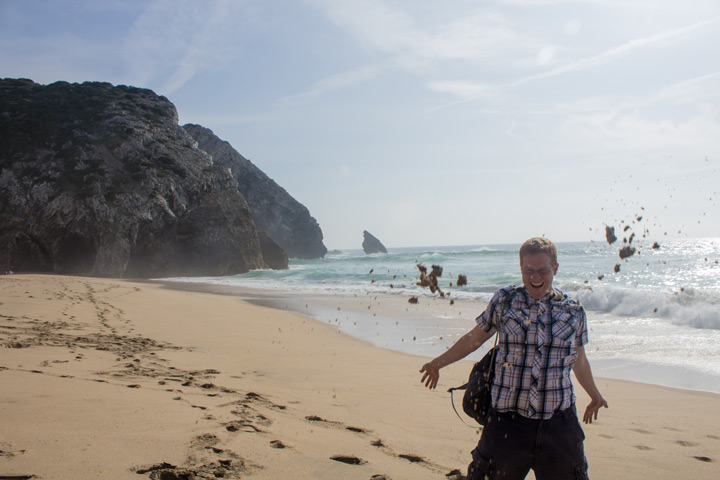
On the other side of Sintra's mountains? Beaches like Praia da Adraga.

Praia da Adraga, just one small ocean away from the United States.

Who doesn't love a good rock formation? Jerks, that's who.
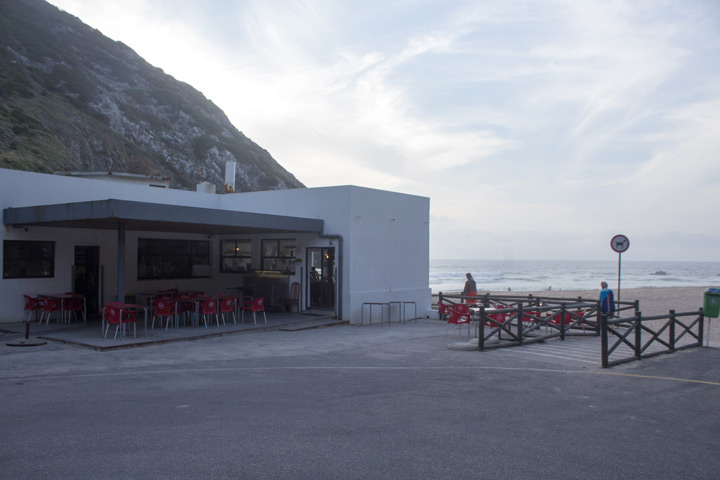
A restaurant at the end of Iberia. Praia da Adraga.
The quick story: Back in the 10th century, the Moors were in charge of Sintra, and they put a big defensive structure on the side of the mountain. This was great military planning. On a clear day, you can see forever: Anyone coming to kill you would be detected well before they got there. The castle is far enough uphill that no one could hit it with Medieval siege weapons. And anyone committed enough to actually try to kill you in the castle would be exhausted after walking uphill in armor. "Ah, screw it" is a very powerful deterrent.
All that being said, s**t happens, and the Moors lost the castle to Afonso Henriques in 1147. The castle didn't see any real military action for a few centuries, but it continued to have a staggering view. And to the credit of the Portuguese royal families, no one ever built luxury condos there. The 20th century dictator also spruced up this property, patching up some crumbling walls and keeping it open for the public's amusement.
This is where the mist really paid off. Castles are always cool. Castles in the mist are even cooler, because they let you pretend that you're in a high-budget production of "MacBeth." There's not much to do but walk the walls (and the many, many steps), but that's all you really need to do.
Vacations are for both of us, but you can classify some days as "Allyson days" or "Chris days." With two palaces and a castle, this was clearly a Chris day. Allyson was never a 12-year-old boy, nor was she that heavily into princess culture. I was a 12-year-old boy, and I also played a lot of Dungeons and Dragons. But I'd like to think that we both enjoyed our time in Sintra. Mostly because it means I don't owe Allyson anything.
We skipped the tuk tuk and took a trail back to town. Shortly after we rediscovered our BMW, which was miraculously un-keyed by the shady parking lot guy. It was still technically the afternoon, and we had a sweet ride. So against all wisdom, I took the advice of my former roommate, Eric Colchamiro. He had been to Sintra with his wife, and he said we should see Praia da Adraga. It's a beach, and if you're going to Portugal you owe it to yourself to see at least one nice beach. Since we weren't heading to the Mediterranean, this was our best shot.
Praia da Adraga is on the Atlantic, which meant we had to get around (or over) the Sintra mountains while heading west. We drove through a few small towns for about 30 minutes, before the smarmy British lady had us turn through one town that seemed like a mistake. The road was maybe one and a half lanes wide, the traffic seemed entirely local, and it did not seem like a BMW was the appropriate thing to be cruising around in. But the road kept descending, which meant the water was getting closer. And it ended in a parking lot ... for a very stunning beach.
The surf was huge and the cliffs were steep. At Sintra, the clouds stack up on the mountain. But the beaches are before the mountain, so we could see blue sky for the first time that day. The beach was mostly empty, so we found a spot and just laid down for 30 minutes. We watched a guy fishing. We strolled on the beach with our shoes off. We enjoyed what swimsuit photographers call "the golden hour," although neither of us was wearing a skimpy swimsuit. As the sun got lower and the air got cooler, we moved back to a little restaurant off the parking lot and had some drinks outdoors. It was a fantastic end to the day.
Only, our day wasn't quite over. In true Portuguese fashion, the beach restaurant was seafood-heavy with no vegetarian options. So we hopped in the car and headed to our hotel for the night, a few hours north in the beach town of Peniche. Driving in the dark, we didn't get to take in much scenery. But we pulled into a very beachy motel, across the street from a surf school and the sand dunes, at around 9:30. Beach towns are beach towns the world over, so we were able to find a pizzeria open at that hour, and we enjoyed our fashionably late European supper.
We also completely junked our plans for the next day, but we'll get to that in a second.
